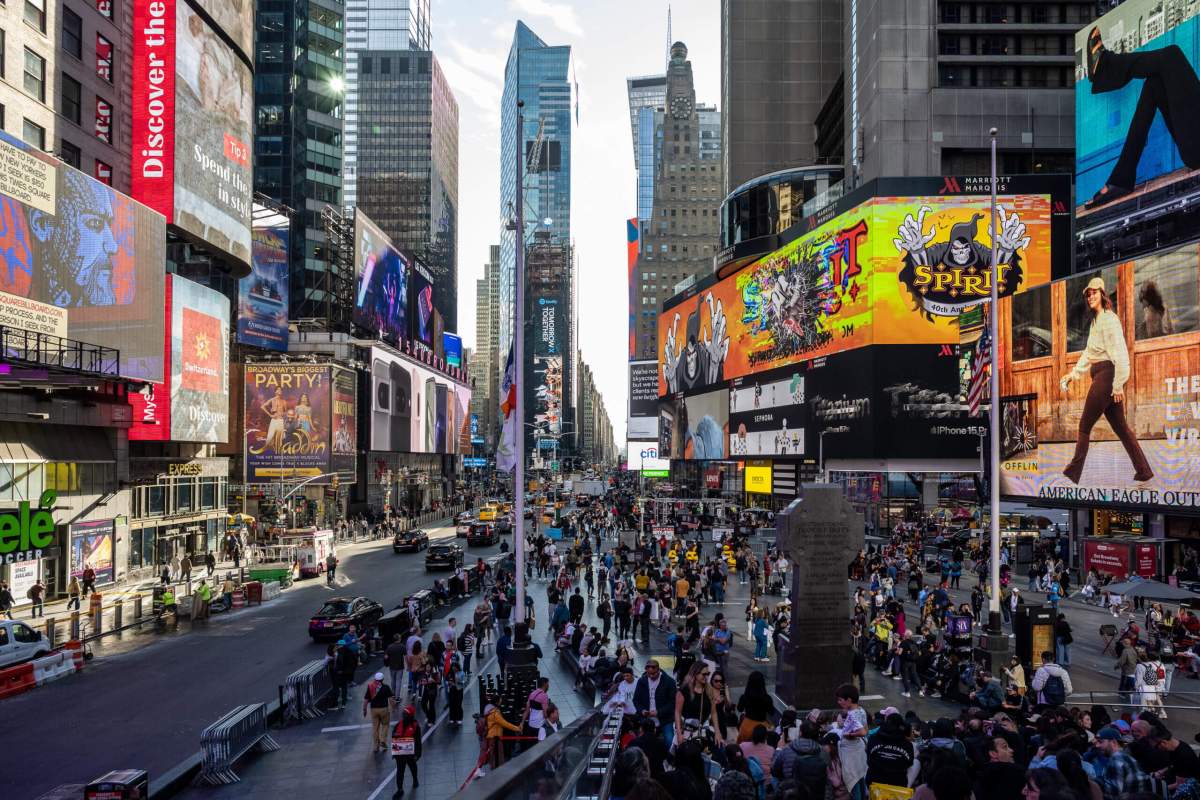Broadway has seen more foot traffic and bigger audiences in the first month since the curtain went up on the congestion pricing era — though it’s too early for some to say whether the Manhattan tolls played a starring or a cameo role in such success.
The Theater District is in the Congestion Relief Zone (CRZ), south of and including 60th Street. In this part of Manhattan, drivers are now charged a base toll of $9 to enter during peak hours.
With popular shows such as “Gypsy,” “Wicked,” and “Sunset Blvd.” packing audiences throughout the season, the theater industry made more money this January with congestion pricing in effect compared to the same period last year.
According to recent theater statistics, January 2025 saw better profits than January 2024. That’s even though January and February are traditionally slower months in the theater world.
The Broadway League, a trade group for the Broadway industry, reported an impressive $32,176,529 in ticket sales the week ending Jan. 12 this year, with congestion pricing already in effect for eight days at the time.
The industry only made $27,657,991 during the same period last year.
The following week, which ended on Jan. 19, 2025, Broadway scored $33,372,166 in sales, up from $23,589,174 the same period in 2024. Closing out the last week of the month this year over last, Broadway was still hitting it big with $29,614,804 in sales in 2025 versus $24,615,726 in 2024.
However, looking at the metrics over recent weeks, Broadway saw a steep decline in attendance and ticket sales in January — not surprising because of the post-holiday slowdown that happens every year. At its peak during the week ending on Dec. 29, 2024, theaters grossed a whopping $55,822,374.
But that number dramatically dropped to $32,176,529 by Jan. 12, just over a week with congestion pricing at play in New York City.
Since then, ticket sales have seen various ups and downs throughout January but never reached that $55 million high point in December.
Has congestion pricing made an impact?

Is congestion pricing playing a big role in Broadway sales? With the tolling program in effect for only about two months, experts say it’s just too early to tell.
“The impact of congestion pricing is too early to judge,” said Cristyne L. Nicholas, chair of the Broadway Association, a business association in Midtown West. “January and February are notoriously slower months when the city is empty.”
Nicholas, whose organization advocated for the pause and a lower congestion pricing toll into the CRZ last year, said her concerns go beyond the Theater District. Members of the local business community and hospitality workers who have a symbiotic relationship with local theaters matter, too, she said, adding that many of these employees work shifts that are not often covered by mass transit schedules.
“We are still concerned that $9 for private cars and much more for commercial vehicles will have a negative impact on the hospitality workers and the tourism industry,” Nicholas said. “We remain open-minded and hope that the result of less traffic will also result in additional money for transit improvements, with minimal impact on workers who have been urged to return to the city.”
On the other hand, Danny Pearlstein, policy and communications director at the Riders Alliance, believes congestion relief has been great for business and tourism.
“It’s now faster and easier to drive or ride the bus to the theater, there’s more company on subways and commuter trains, and street life is more vibrant than before,” he said. “The program is quickly proving itself a big winner to New Yorkers, commuters, and visitors from all over. After a rough patch, this is really putting New York back on the map.”
John McCarthy, chief of policy and external relations at the MTA, said less gridlock is good for business, including Broadway.
“Most theatergoers take subways, buses, bikes, cabs or walk to shows,” McCarthy said. “The relatively few who drive are seeing much less traffic. So, no surprise that attendance and ticket sales are way up.”
Foot traffic up
Whatever the season, Broadway, being in the heart of the world-famous Times Square, has always been attractive to pedestrians who enjoy seeing shows, browsing local shops, dining, and taking in the vibrant sites and sounds.
The Times Square Alliance even noticed a 7% increase in the district’s foot traffic in January compared to the same period last year.
An alliance spokesperson said it’s just too early to tell how congestion pricing has impacted local businesses and stakeholders in the area.
Lauren Becker, DDS, PC, a dentist whose practice is located in Madison Square North, said congestion pricing has not affected her business or her travels to Broadway and Times Square.
“It hasn’t stopped me from enjoying my favorite parts of NYC either,” the doctor said. “If I can’t get to Broadway by train, I can walk or I’m happy to pay the toll price in a taxi.”
And there are other theater-loving New Yorkers who agree.
“It doesn’t matter to me whether there is a toll to enter into Manhattan or not because I’d always prefer to take the bus or trains into the city, especially to Times Square,” one New Yorker said.


